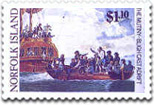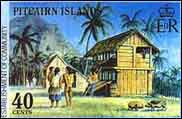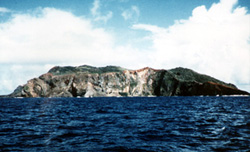The Bounty, Pitcairn Island, and Fletcher Christian's Descendants

April 28 marks the anniversary of the world's most famous mutiny
by Borgna Brunner |
 HMS Bounty Phrases in the Pitcairnese DialectI starten. – I'm going. Bou yo gwen? – Where are you going? I gwen down Farder's morla. – I'm going down to Father's place tomorrow. Bou yo bin? – Where have you been? I gwen out yenna fer porpay. – I'm going out yonder for red guavas. Foot yawly come yah? – Why did you come here? Up a side, Tom'sa roll. – Up at that place, Tom fell down. Source: Ray and Eileen Young, New Zealand residents descended from Midshipmen Edward Young of the Bounty. Courtesy of the Pitcairn Island Web site. |
It is not surprising that the most famous of all mutinies, that of the British HMS Bounty, has become ideal fodder for popular history and legend. The mutiny has generated five films (who can think of Fletcher Christian without picturing Marlon Brando?) as well as countless books (including a historical novel by Mark Twain, The Great Revolution in Pitcairn).
Set in the paradisiacal islands of the South Seas, the mutiny involved a host of colorful characters, including the tyrannical Captain Bligh, the aristocratic Fletcher Christian (a distant relation of William Wordsworth's), numerous uninhibited Tahitian women, and a pack of sailors made up of cockney orphans and ruffian adverturers.
Anglo-Tahitian Culture Preserved
What has also helped to perpetuate the romantic fascination with the mutiny is the existence of a small community on Pitcairn Island directly descended from the mutineers and their Tahitian wives.
Living on a 1.75 square mile volcanic speck in the South Pacific that is surely one of the most isolated places on Earth, the contemporary Pitcairn Islanders still bear the surnames of the eighteenth century mutineers (Tom Christian, for example, is the great-great-great-grandson of Fletcher). The islanders speak a dialect that is a hybrid of Tahitian and eighteenth-century English. It is as if history had been preserved in a petri dish (another admittedly romantic notion about an already widely romanticized past).
Paradise
The Bounty left England on Dec. 23, 1787, and reached Tahiti in 1788. It was sent to collect a cargo of breadfruit saplings, which was then to be transported to Jamaica where the breadfruit would serve as food for slaves working on the plantations. After sailing 27,000 miles over ten months, the crew spent a sybaritic idyll on Tahiti, where they reveled in the subtropical climate, lush surroundings, and overwhelming warmth and hospitality of the Tahitians.
A scientist of the time, gladly abandoning reason for passion, claimed that the Tahitians knew "no other god but love; every day is consecrated to it, the whole island is its temple, all the women are its idols, all the men its worshippers." Many of the men found Tahitian companions, and Fletcher Christian and a Tahitian named Maimiti fell deeply in love and later married. For Christian, Maimiti had the face that launched one mutinous ship.
Breadfruit Bligh

On April 4, 1789, the Bounty embarked on the second leg of its journey with a cargo of a thousand breadfruit saplings aboard. A little more than three weeks later, near the island of Tonga, the crew, led by first mate Fletcher Christian, staged a mutiny against Captain William Bligh, under whom they claimed to suffer inhuman treatment.
Bligh and eighteen loyal sailors were set adrift in a 23-foot open boat. According to Captain Bligh's diary, the mutineers threw breadfruit after him as he was forced off the Bounty, and yelled, "There goes the Bounty bastard, breadfruit Bligh!" Miraculously, Bligh and his loyalists survived the seven-week, 3,600-mile voyage in the cramped boat, finally reaching the island of Timor.
Discovering Pitcairn
 Pitcairn's coordinates are 25 04 S, 130 06 W. |
After the mutiny, Christian and his sailors returned to Tahiti, where sixteen of the twenty-five men decided to remain for good. Christian, along with eight others, their women, and a handful of Tahitian men then scoured the South Pacific for a safe haven, eventually settling on Pitcairn on January 23, 1790.
An isolated volcanic island 1,350 miles southeast of Tahiti, it was named after British midshipman Robert Pitcairn, who first sighted the island on July 2, 1767. Its location had been incorrectly charted by the explorer Carteret, who missed the mark by 200 miles, and was therefore the ideal refuge for the mutineers. Although a British ship spent three months searching for them, the mutineers eluded detection. Those who had remained on Tahiti were not so lucky. They were swiftly captured and brought to trial in England, where seven were exonerated and three were hanged.
Psychoanalyzing Captain Bligh
The circumstances leading to the mutiny remain unclear. History has alternately presented William Bligh as horrifically cruel or as a disciplined captain merely running a tight ship. Scenes from movies in which he keel-hauled sailors or gave their water rations to the breadfruit plants have no historical basis, but diplomacy and compassion were clearly not his strong suits. In short, the captain is believed to have been a foul-tempered, highly critical authoritarian with a superiority complex.
Bligh himself contended that the mutineers "had assured themselves of a more happy life among the Otaheitans [Tahitians] than they could possibly have in England, which, joined to some female connections, has most likely been the leading cause of the whole business."
Bligh Climbs the Naval Ladder Rather than Walking the Plank

Certainly the stark contrast between the pleasures of Tahiti and the bleak life aboard the Bounty played a role in igniting the mutiny, but the blame seems to rest largely on Bligh's failings as a captain. The fact that Bligh was later involved in yet another mutiny and again accused of "oppressive behavior" makes the occasional attempts to rehabilitate his reputation unconvincing. In 1805 he was appointed governor of New South Wales, Britain's colony of Australia. The colonists, well accustomed to harsh leaders and conditions, found Bligh's rule intolerable. Within three years, they mutineed; Bligh was imprisoned and sent back to England.
p> Ironically, having two mutinies on his record did not stymie Bligh's career–he was eventually promoted to Vice Admiral. Although he was arrogant and cruel, he was also courageous and intelligent, as well as an excellent navigator, astronomer, and cartographer–he could never have survived the seven-week, 3,600-mile post-mutiny voyage otherwise. The Ebb & Flow
| ||||
Landing on Pitcairn Island in 1790, the mutineers and Tahitians remained invisible to the world for eighteen years. Despite the fledgling society's opportunity to invent itself from scratch, island culture more closely resembled Lord of the Flies than a Rousseauvian utopia. When an American whaler discovered the island in 1808, murder and suicide had left eight of the nine mutineers dead.
Pitcairn Joins the Commonwealth
Pitcairn flourished under the leadership of the last surviving mutineer, John Adams, a Cockney orphan who had joined the Bounty under the pseudonym Alexander Smith. He reverted to his real name on Pitcairn–apparently deciding it was the sort of place where he could let his hair down. Adamstown, the capital, is named after him.
Despite his former hard-drinking days and near illiteracy, Adams emphasized the importance of religion and education to the Bounty's second generation–which included Fletcher Christian's son, Thursday October Christian, the first child born on the island.
In 1825, a British ship arrived and formally granted Adams amnesty, and on November 30, 1838, the Pitcairn Islands (which also include three uninhabited islands–Henderson, Ducie, and Oeno) were incorporated into the British Empire.
Emigration to Norfolk Island
By 1855, the population had grown to nearly 200, and the tiny island, with only 88 acres of flat land, could no longer sustain its people. As a result, Queen Victoria bequeathed them Norfolk Island, a former penal colony more than 3,700 miles to the west.
On May 3, 1856, the entire population of 194 people reluctantly abandoned Pitcairn. Within 18 months, however, seventeen of the immigrants returned to Pitcairn, followed by another four families in 1864. Contemporary Norfolk has approximately 1000 Bounty descendants–about half its population–and celebrates Bounty Day (the day the Pitcairners first arrived) on June 8.
Contemporary Pitcairn
StatisticsIsland Mayor: Mike Warren (2007) |
Today about 50 people live on Pitcairn. All but a handful–a pastor, the schoolteacher, and others–are direct descendants of the mutineers. The only way to reach the island is by ship, but storms and Pitcairn's dangerous harbor have sometimes prevented landings. In recent years one of Pitcairn's thrice-annual supply ships ran aground on a reef on its way from Norfolk to Pitcairn.
Mail service takes approximately three months, and for medical attention, Pitcairners must wait for a ship to transport them to New Zealand, several thousand miles to the west. All are Seventh-Day Adventists who converted sometime after 1886, when an American missionary arrived on the island.
The islanders support themselves by producing postage stamps and making handicrafts, which they sell primarily to visitors on passing ships. Their meager revenue does not cover the enormous costs incurred in keeping the remote island running–electricity, among other things, is exhorbitant and cargo costs several thousand dollars per ton to transport. Great Britain has until now subsidized the island, but it is uncertain whether it will continue to underwrite the expenses of its tiny but costly colony.
World Wide Web Brings the Wide World to Pitcairn
There are individuals and organizations around the world devoted to the Pitcairners, their genealogy, and the history of the mutiny (the genealogical tree extends to 7,500 known descendants throughout the world). Friends of the Pitcairn Islanders have even launched the island into cyberspace–the Pitcairn Island online portal, and Norfolk Island has its own site. It is now even possible to buy Pitcairn Island handicrafts through the Pitcairn Island Online Shop!
Pitcairn has also recently begun to sell its Internet domain name–".pn"–to those needing a unique URL. "Yahoo.com" may be out of the question, but "Yahoo.pn" just might be up for grabs. Islander Tom Christian originally sold the rights to the ".pn" domain to a British Internet company. When the cash-strapped islanders realized they were seeing no financial reward they fought for and eventually took back control of their domain name.
 Pitcairn Island. Courtesy of the Pitcairn Island Web Site. |
Paradise Lost
In recent years, however, a sexual abuse scandal has cast a deep shadow over the island. Accounts of the victimization of women and young girls on Pitcairn began surfacing in 1999. Seven men–more than half the adult male population of the island–were charged with 96 counts of abuse, including rape and sexual assault. Some of the charges dated back four decades. Subject to British law, the accused faced trial in October 2004 on Pitcairn. Three judges, a number of lawyers, and legal staff members made the 3,000-mile journey to Pitcairn from New Zealand. Eight women, all former Pitcairn Islanders, testified by video link from Auckland, New Zealand.
On Oct. 29, 2004, four men were convicted of multiple sex offenses and received jail sentences of up to six years; two others were sentenced to community service. Jay Warren, the island's magistrate, was found innocent. The appeals of all four men were dismissed, and they are currently being jailed on Pitcairn and guarded by a prison staff from New Zealand.
